Last Updated on February 21, 2023 by Kirsten Raccuia
In Penang, food is a pastime, a sport, a national treasure. Most places have sports teams that they root for, argue over, have heated debates about. Not here. It’s food. And I’m not talking about fancy, white-tablecloth restaurants you go to on a date night. Although we have those too. I’m talking about the best hawker food in Penang.
The lifeblood of Penang and its people is the street food. The stuff served on melamine plates, which usually comes without a napkin, and is served at big metal tables surrounded by plastic lawn chairs. There is nothing fancy about this food, but it’s some of the tastiest bites you’ll find in Malaysia.
There are thousands of street food stalls spread throughout the island.
But instead of bouncing around from street to street, go to a hawker center. It’s where you can try all the best street food in one place.
The challenge of going to a hawker center is that it’s super overwhelming. There are more than 50 stalls, each cooking a couple of different dishes, so it’s like having a menu with over 150 options on it.
So what do you order?
That’s where this blog comes in. I’m about to guide you through the best hawker food in Penang.
Grab a glass of wine and something to snack on, because you are going to get hungry…I promise.
What is a Hawker Center?
Think of it as a one-stop-shop for food for all the best hawker food in Penang. It is an outdoor food court. But not the kind you find in American malls with McDonald’s, Sbarro, and Cinnabon.
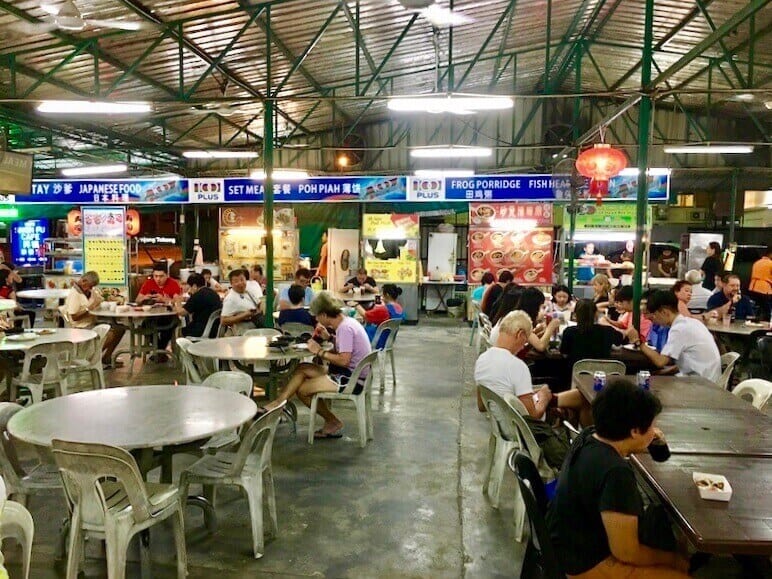
These food courts have individually owned and operated stalls where they cook recipes that have been handed down through the generations. It’s local food as gramma used to make. Each stall specializes in a couple of dishes. It’s all they sell, sometimes to the tune of 500+ plates a night.
It is where the locals eat; it’s part of the culture.
How to Eat at a Hawker Center
We had never heard of a hawker stall until we started planning our Penang vacation in 2012.
Generally, we aren’t advance planners on vacation. We’re more the wander and get lost, kind of travelers. We had no idea what to see and do in Penang. But after watching Anthony Bourdain eat his way around Penang in No Reservations, we knew exactly where to eat. We were going to follow in his food-steps – see what I did there?
I remember the first time we walked into a hawker center. We went to Red Garden and were thoroughly overwhelmed. Even though we knew what to expect, the choices were mind-boggling. Duck tongue, rojak, curry mee, poh piah, passembur, lobak, frog porridge, the options were endless.
Six years later, I’m an expert. Follow these steps, and you will be too:
1. First, walk around and get a lay of the land. Decide what you’re going to eat.
2. Find a place to sit and look for the table number. A drink server will come to take your order. Once you get them, you can leave your table, and no one else will sit there.
3. Go to each of your chosen food stalls and place an order. Tell them your table number, but don’t pay. Go back to your table and wait for your food to arrive. You pay for your food as it comes to your table.
4. Eat, enjoy, repeat until you’re full.
What to Eat at a Hawker Stall
Char Kway Teow
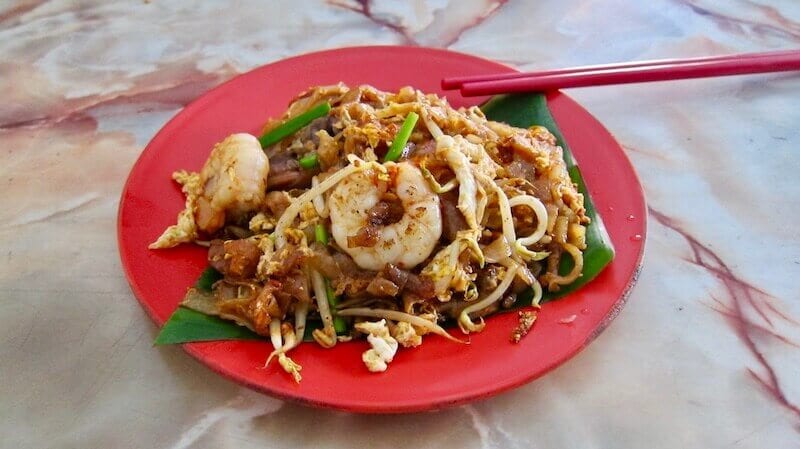
This Chinese noodle dish is one of the best hawker foods in Penang and the reason this island is on the foodie map. It’s one of the national dishes like pad Thai is in Thailand.
The best char kway teow is cooked in a searing hot wok heated by charcoal. They toss glossy rice noodles with a couple types of soy sauce, sometimes a dash of fish or oyster sauce, and always some chili boh, or chili sauce. Throw in some chives, an egg, a handful of crunchy bean sprouts, and my favorite, thinly- sliced Chinese dried sausage. Some places add in cockles and pork cracking for extra fatty richness.
The whole process takes about 2 minutes per plate, and it’s usually served on a banana leaf.
When the hot noodles touch the banana leaf, it cooks it slightly, which releases a little earthy aroma.
Not the prettiest plate; it’s all pretty brown, but it’s beyond delicious and a local fave.
The cost: It generally costs between RM5-7 ($1-2), more if you add duck eggs.
Char Hor Fun
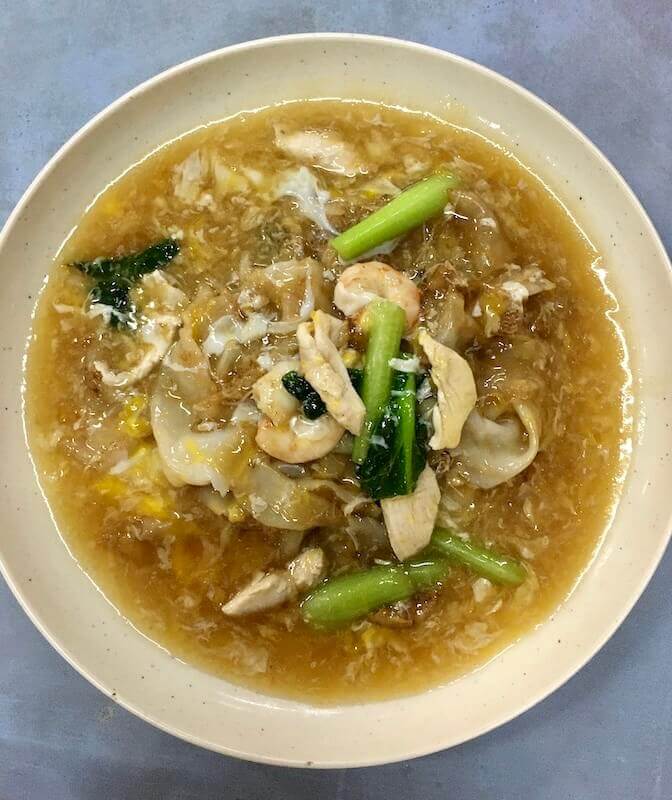
This is a perfect dish for those who like milder, more subtle flavors. It’s a noodle dish that has slices of pork, leafy Chinese mustard greens (chai sim), and prawns in it.
It has two types of noodles: wide flat rice noodles (hor fun) and skinny vermicelli noodles. The noodles are lightly toasted and charred, which gives them a delicately smoky taste.
The gravy is a thick light brown viscous blend made from a base of corn starch. The cook mixes an egg into the thick sauce to make it extra silky and creamy. It’s served with a side of pickled jalapenos for a little kick.
Again, it’s not the prettiest of dishes, but it certainly a comforting one.
The cost: Usually between RM5-7 ($1-2).
Ikan Bakar – grilled fish
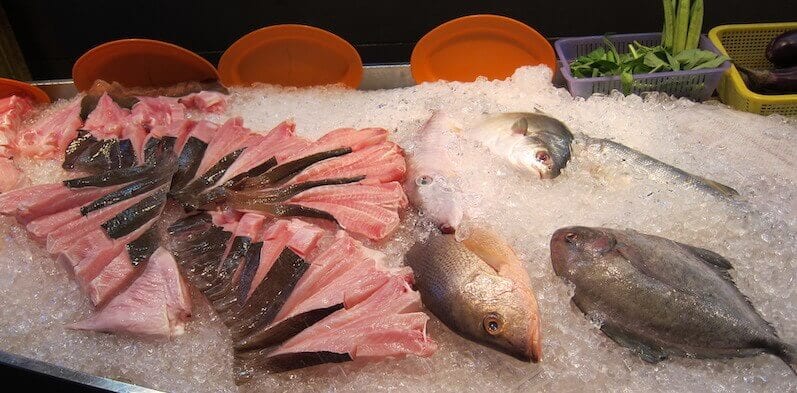
Every hawker center has at least one seafood stall where you can get fresh prawns, squid, various clams and snails, and an assortment of locally caught fish, all displayed over ice.
These are great stalls for any seafood option and usually, have veggies you can choose from too.
BBQ stingray has become one of our favorite dishes and is def one of the best hawker foods in Penang. It’s a boneless white fish which makes it easy to eat. It is cut into rough triangles and has a center made of crunchy-chewy cartilage.
It’s All in the Sauce
What makes this dish so incredible is the rub and the homemade sauce. It is different at every stall, and Penangite will argue over which one is best.
Before putting the stingray on a flat-topped grill, the cook rubs it with a curry paste. They cook it low and slow on a banana leaf, so the delicate fish doesn’t burn. When the edges char a bit, they flip it and add more curry paste.
It is served with a side of sour tamarind sauce that has shallots, torch ginger flower, and spicy chilis.
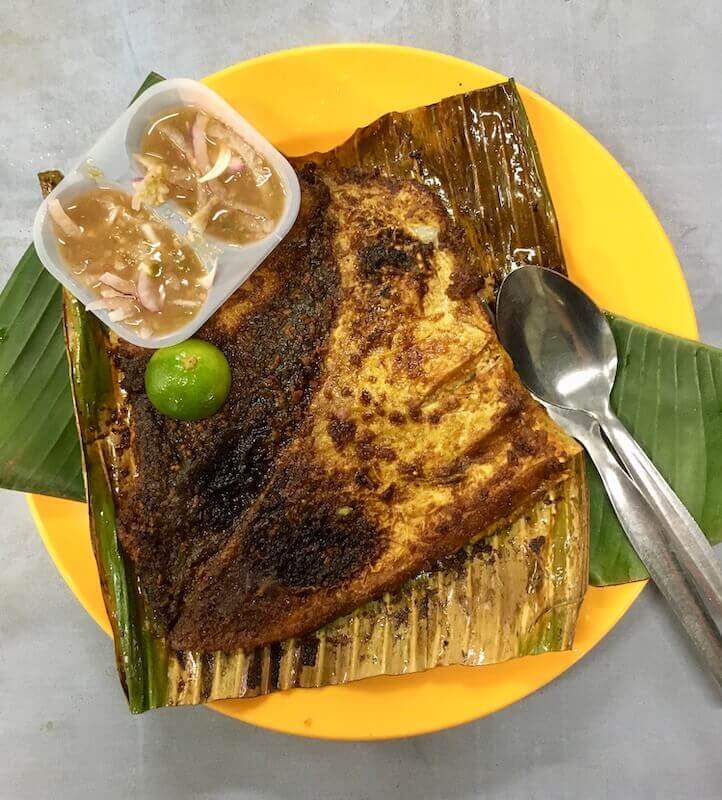
Before digging in, squeeze the calamansi lime over the top and scrape the meat away from the center cartilage, it will pull apart easily. You can eat the center cartilage; supposedly, it is healthy for your joints. But people on this side of the globe say that tiger’s balls are good for you too, so who really knows?
The cost: once you choose your piece of fish, they will weigh it for you and tell you the price. A small portion for one person starts around RM12 ($2.88).
Want more juicy tidbits? Why not read about food in Laos and Greece.
Laksa
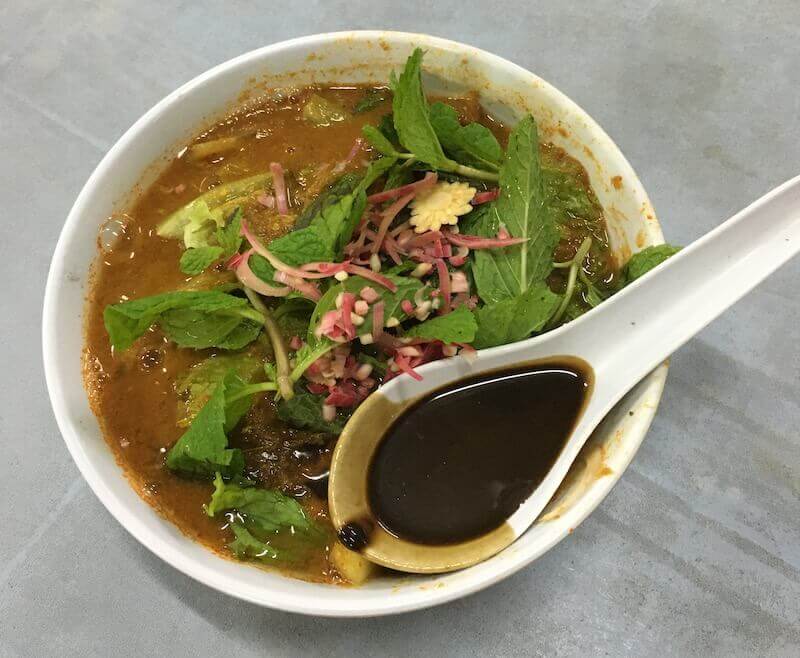
Ok so this isn’t just one of my faves, it’s number seven on CNN’s list of the World’s 50 Best Foods.
There are various types of laksa, but assam laksa is Penang laksa. It is a fragrant bowl of spicy/sour broth made of mackerel, tamarind, and chilis. They cook the mackerel down for hours in a tamarind sauce, which breaks down the fish and forms a rich base.
There is a long list of over 15 ingredients, which means I’ll never cook it at home, especially when we can go out and get a bowl of it for RM6 ($1.45).
I’m not going to bore you with the ingredients but safe to say write; it’s a hot bowl of incredible flavors that don’t make sense together. Yet it’s an explosion of flavors that tastes like heaven.
The dark red broth is thick and loaded with slippery white noodles, slices of cucumber, red onion, lettuce, and for a pop of flavor, they add mint and pineapple. It might not sound appetizing, but for some reason, it all blends together harmoniously.
It comes with a spoon full of local shrimp paste to add a little extra umami. DO NOT; I repeat DO NOT, just throw that spoonful willy-nilly into the laksa without tasting it first. It’s shrimp paste, and it can be mighty fishy, so a little dab will do ya.
Laksa was one of Anthony Bourdain’s faves, “It’s everything I love in one bowl.”
Satay
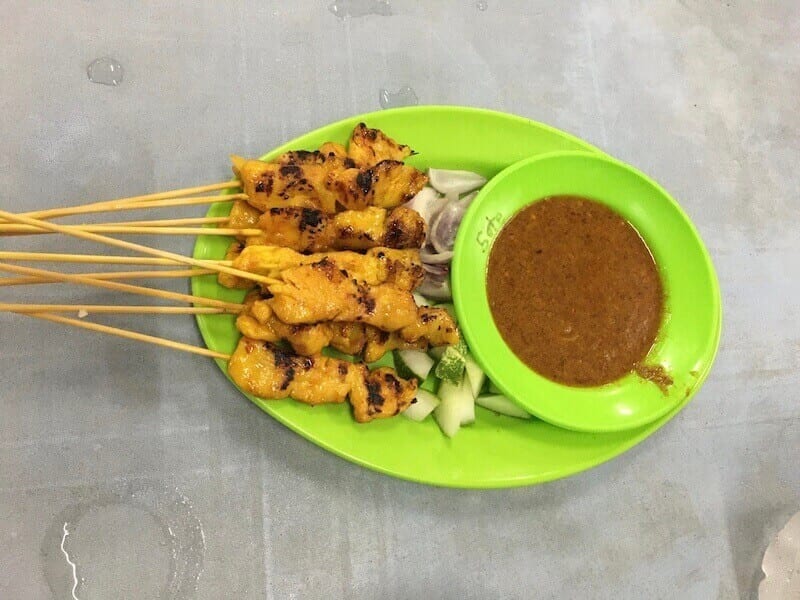
Satay is one of those foods that everyone loves. It’s a people pleaser. It is deceptively simple and a staple at every hawker stall in Malaysia.
Satay is grilled boneless, skinless chicken pieces that have been marinated overnight in spices and served with sweet and spicy peanut sauce.
The marinade has turmeric, ginger, coriander, chili, salt, sugar, lemongrass, garlic, and shallots all blended into a paste and rubbed into the meat. Then they skewer it and cook it over a charcoal grill, while fanning the flames, to get a good char on the chicken. It is served with a side of sliced of cucumber, red onion, and sometimes slices of rice cake called ketupat.
The peanut sauce can make or break a good satay. It needs to be perfectly balanced between sweet, spicy, and of course, peanutty.
Each stall usually has an option for lamb or beef satay. But honestly, it’s just not that good. Stick with chicken, and you’ll be happier.
The cost: 10 skewers for RM12 ($2.88).
Chicken Wings
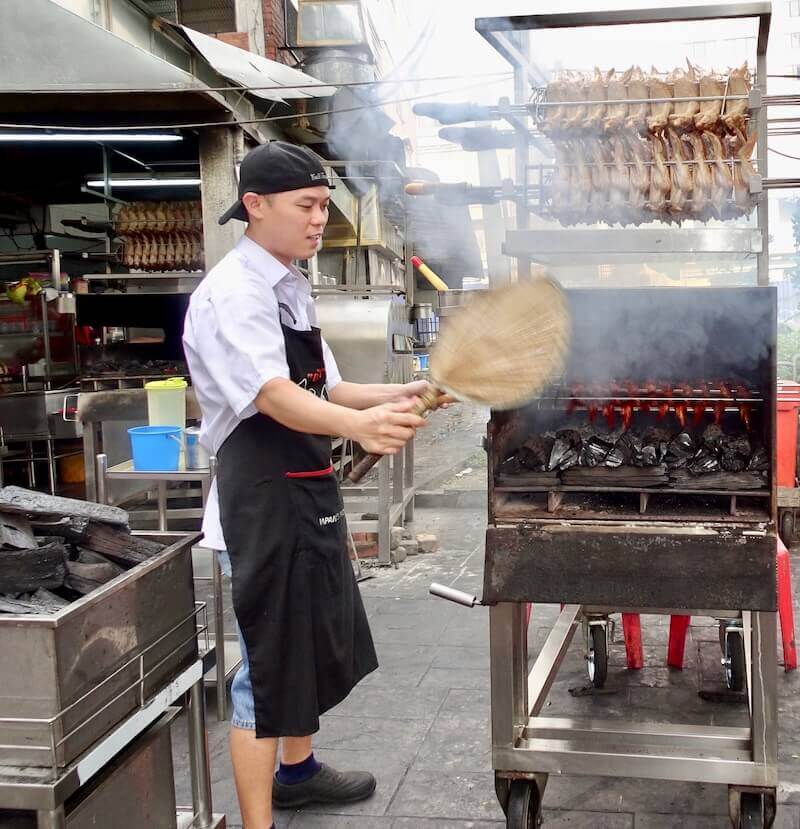
These aren’t your typical American type wings. They aren’t even buffalo wings. These are spicy, sticky, messy wings that are caramelized over an open flame and then served with spicy chili sauce.
They are glazed with honey, a blend of soy sauces, sesame oil, and some other ingredients that I’ll never know. No one, and I mean no one, is giving up their gramma’s secret recipes unless you’re family and taking over the business.
These are up there with satay for the best hawker food in Penang. Every hawker center has them, but it’s all about the sauce. Some places make a sweet sauce, while others have more spice. I prefer the spicy kind over the sugary style.
You’ll find rows and rows of wings slowly roasting over an open fire. You can see the fat and juices dripping into the flame, causing little bursts of scented air to waft your way. I always over-order wings, and I blame that scent for enticing me to order more than I need.
However, in six years, we have never left a wing uneaten.
If you aren’t excited over wings, you can get a quarter chicken as well. Have them chop it up, bone and all, into bite-sized pieces. It’s easier to eat and share it that way.
The cost: RM 2.50-3 ($.60-72) for the wings. RM6-8 ($1.45-1.92) for the quarter.
Lok-Lok
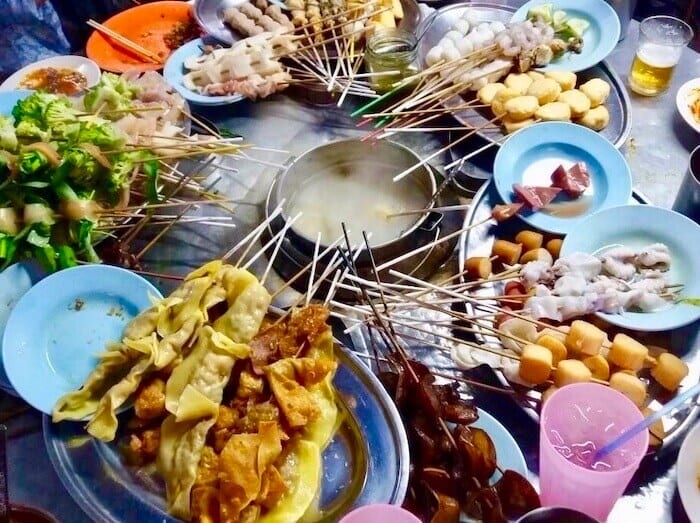
Lok-lok stalls have specialized tables; each one is fitted with a vat of boiling water in the middle. The stall puts hundreds of skewers of food on each table. The skewers have meat, seafood, tofu, fish balls, dumplings, or veggies. Almost everything is raw.
Unlike all other hawker food, lok-lok, you cook for yourself. Grab a skewer of your choice and dip it into the boiling water to cook it. Then dip it into one of five sauces: peanut, lemongrass, garlic-shallot, BBQ, or tom yam. Lok-lok means dip-dip, now you know why.
The tip of every skewer is color-coded by price, ranging from RM1 to RM5.
When you are finished eating, you give the waiter your collection of skewers, and he counts aloud in Hokkien, no calculators, no fingers, just math in his head.
So, the deal with lok-lok is that it’s not usually in the big hawker stalls. Lok-lok stalls are strewn around the city, but my favorite, hands down, is at the Pulau Tikus night market. Lok-lok is one of the best hawker foods in Penang. There is something for everyone.
It’s not just about the tasty, affordable food at hawker stalls. There is entertainment, too.
Sequins and Sashes
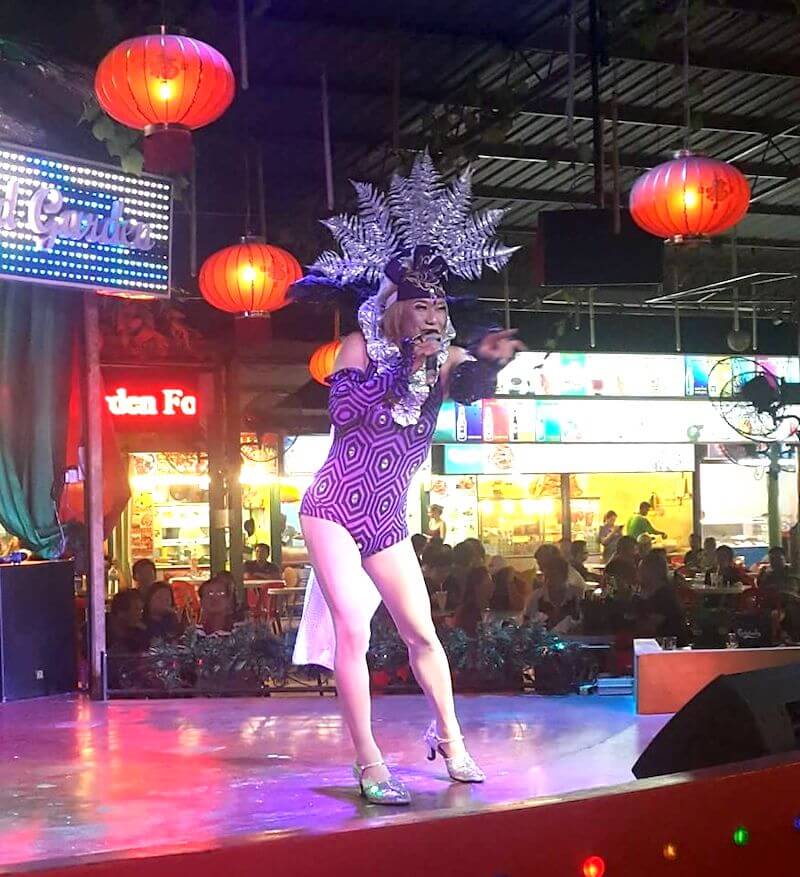
@redgarden facebook
You thought you were just going there for the food, but let me tell you, there is some serious entertainment at Penang hawker stalls.
There is usually one lone keyboardist and 3-5 singers each night. They are all dressed in matching sequin vests, or cowboy hats, some are ladyboys, and there is even an Elvis impersonator who makes the rounds.
Sometimes they sing Adele, and sometimes they sing in Mandarin, which to my white-girl ears sounds like cats mating. These singers are never fabulous, but they are always entertaining.
If you’re lucky, local Chinese couples wearing their finest getups will start ballroom dancing.
They don’t tip here, so they buy the singer a sash and go up to the stage and place it over their head. Each sash is worth a certain amount of money. At the end of the night, the singer trades in their sashes for cash.
It can be really cheesy. But the locals love it, and you can really get an insight into the culture here.
Hungry yet?
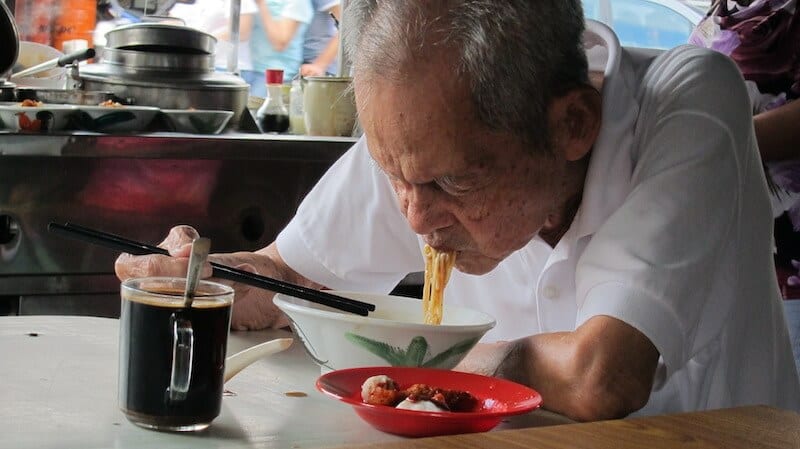
Hawker centers are all over the city, but my faves are Red Garden, Northam Beach, and CF near Weld Quay.
Not eating street food in Penang is like ordering a cheeseburger in Rome; it simply isn’t done.
There are tons of incredible proper restaurants here, but you’ll be missing out if you spend more money to have a porcelain dish.
The bigger the group you go with, the more you get to try. Nothing costs more than a few bucks, so get adventurous, try that duck tongue. Or not, it wasn’t that good, stick to laksa.
If all else fails, and you’ve forgotten everything I’ve just written, ask the locals. Look at what they are eating; if it looks good, ask them what it is, and they will help you out. You will end up chatting about the local fare and might even end up joining their table for dinner.



Hi
Any recommendations for a celiac in Penang? Thankyou
Sorry Andrew. I’m not sure about that.
Hi, Kirsten,
Stumbled into your blog by accident while skimming thru Quora, so nice to read about the food that I enjoyed while growing up in Penang. Every time I miss home or the local food when I’m travelling (not now), I will go to your blog and reminiscence, while slurping a bowl of assam laksa (in my head). You missed out our local (original) prawn mee, called Hokkien mee by the locals which you can’t get anywhere else in Malaysia and even the ones in Pg are not up to par unless you do some searching…
Let me know if you want any recommendations to try Hokkien mee, Curry mee, Nyonya nasi lemak (really different), Mee Goreg/Rebus mamak, Nasi Dalca, Hokkien Char, Nasi Kandar, Tosai Bawang, Popiah, fruit rojak, Pasembor, chendol, Nyonya kuihs and many more!
Hi Sammy! Welcome and thank you for reading!
I am thrilled to be able to bring you back to Penang – via your stomach. There are a lot of foods I left out, didn’t want to overwhelm. But you’ve given me the idea to write a part 2.
I love Hokein mee, a fave breakfast food for us, besides roti canai.
Mee goreng and pasembor aren’t my faves, but maybe I need to eat them at a better place.
I’d love recommendations! Gives me something to look forward to after we get out of lockdown.
Do you ever get back to Penang?
Really liked your food descriptions and other info. I will be coming to Penang for about a month in November. I have a concern about sugar in food there. I’m a diabetic so need to know if it is sugar free…obviously no desserts for me. Hope you will respond. Thanks
Hi Pamela,
Thank you. Yes, there is food with sugar in it, just like in every country. But you can always ask for things to be made sugar free, like coffee, fruit juice etc. I hope that helps.
Okay, all of this sounds AMAZING. Also, it took me longer to get that food-steps joke than I care to admit.
Hi Emelie!
Hahah! I bet you are not alone with the food0steps joke. I am pretty sure most of my jokes go either unnoticed or just aren’t funny! I need to take some tips from you!
XO,
K
Hi sweetheart, what a great blog. Of course I have had the advantage of being there with
You on manta different occasions and have never been disappointed. Some times I didn’t even know what I was eating. You never streared me wrong. Although sometimes I can be a little Squamish, I can’t wait to get back there again. Love you!!
Hi mama!
You were never squeamish unless it was a whole fish. And even then it wasn’t the googly eyes, it was the bones. I’d say you are an accomplished street food eater! You made us very proud!
Can’t wait for you to get your skinny ass back here so I can fatten you up!
Love you, mama!
K2
I can’t wait to get back there either. Love you so much
I can’t wait to get there either. Love you sweetheart
Another great post! Can you tell me what ‘economy rice’ or ‘economy food’ actually means?! I see it in hawker stalls all the time and still have no clue! Thank you for the introduction to stingray though – yum! 😊
Thank you, Wendy!
Economy rice is a buffet of homemade foods that they sell by weight, or by the piece. If it is Malay food, it’s called nasi Melayu or nasi campur. I’ll take you to my fave place, Lidiana’s, by the floating mosque. No matter what it is called, the food is always fresh and def worth trying. You can get a little bit of everything and try all sorts of new things.
XO,
K
Economy rice probably had its beginning in the Prangin road area where the trishaw paddlers and man on the street get their cheap daily meals.
Today, it is still a staple for college students, blue collar workers, and the working class.
The “smorgasbord” would spoil you for choices. Check out the one at the corner of Lorong selamat and Macalister road. The setting is cleaner and air-conditioned with rows of dishes for your picking. You would find the Economy rice stall in most hawker centresvbut, the quality of the dishes differ.
If you are more adventurous, try the spicy smelly beans or sambal petai and stuffed local mackerel with chilli paste. There is another Malay nasi campur in Teluk bahang called Alaf Sejahtera. Give it a try…
Hi Yeoh!
Thanks for stopping by my blog!
I didn’t know where economy rice came from, just that it was cheap eats. I love the smorgasbord because I like to try a little of everything!
I love stinky beans, eat them as often as I can! I even tried to make them once but they weren’t as good as when we eat them out.
I’ll for sure try that place in Teluk Bahang, so curious about that mackerel dish.
Thanks for all the tips!
K
Ah, ok, thanks! Yep, there are loads of places you need to take me too…Lok Lok being one of the first! x
Hey Wendy!
Ok, one place at a time. I have a great idea…why don’t you move here so we can do it all?😉
XO,
K